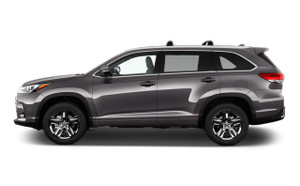Crossover buying guide
By Kijiji Autos
If you need a vehicle that can tow a heavy trailer, or traverse big obstacles in the middle of nowhere, then you need to shop for a traditional body-on-frame SUV. But if your vehicle will spend most of its life crawling through the urban jungle, then a crossover utility vehicle might be right for you.
What Is a “Crossover”?
By definition, a crossover or CUV (Crossover Utility Vehicle) is a sport utility vehicle that sits on a car chassis instead of a truck chassis. (Quick note: a frame is the main metal skeleton that everything is bolted to, while a chassis is that frame with the basic mechanical parts attached (wheels, axles, suspension, etc. – no body parts.) For example, the Toyota Highlander is more of a crossover than an SUV because it is based on a car chassis – the same front-wheel drive chassis as the Toyota Camry. By contrast, a traditional SUV like the Chevrolet Tahoe rides on a traditional, rear-wheel drive ladder frame chassis shared with other pickup trucks in the GM range.
Advantages of a Car-Based Crossover
Gas Mileage
A car chassis is lighter than a truck chassis, and most are designed to use more efficient 4- and 6-cylinder engines.
Driveability
A car chassis provides a lower center of gravity than a traditional SUV. This reduces that tipping-over feeling (called “bodyroll”), and allows the crossover to handle like the car on which it’s based. The front-wheel drive (FWD) arrangement provides confident handling and adequate grip in most situations. However, buyers who need maximum traction for winter driving may want a crossover with all-wheel drive (AWD). Many of the modern AWD systems now offer a Lock function, which keeps the power delivery split 50:50 between the front and rear axles.
Ride Quality
The body of a traditional SUV is typically bolted on top of a ladder frame, and this body-on-frame construction often results in a choppy ride and top-heavy handling. In a crossover, however, you won’t feel as much body movement (if you want to know the details, it’s because the body of the crossover uses integrated front and rear subframes). In addition, the lower center of gravity allows the springs and shocks to be tuned for a smoother ride.
More Interior Room
Many traditional rear-wheel drive (RWD) sport utility vehicles require front-to-rear floor tunnels to accommodate the driveshaft (the shaft running the length of the vehicle that translates the engine’s power into making the wheels turn). The rear cargo area often has protrusions to cover up suspension bits. Plus, the step-in height is typically quite high. This all takes away from your elbow (and leg, and foot…) room inside.
By contrast, a car-based CUV usually has a flat floor, which provides more room for passengers and cargo. The step-in height is about the same as a minivan, which is to say minimal. Its space-saving car chassis and suspension allows for a lower floor and more room in the cargo area. That extra cargo room can also be used for third row seating.
Disadvantages of a Car-Based Crossover
Reduced Off-Road Capability
A car-based CUV isn’t as capable off-road for several reasons:
1. Reduced Ground Clearance – A FWD car chassis typically sits low to the ground, reducing the clearance between the underside of the vehicle any obstacles that you’re trying to climb over. However, crossovers like the Subaru Outback and Jeep Cherokee are designed to provide enough ground clearance for “light” off-roading.
2. Limited Wheel Articulation – This is a fancy term that means the crossover’s wheels can’t move as much as an SUV’s wheels, limiting its ability to clear those same pesky obstacles. On a FWD car chassis, the axles are connected to a subframe, which is bolted directly to the body. With nothing connecting the front and rear subframes, the body has to absorb the twisting and flexing forces that result as the wheels move up and down to clear obstacles. To protect the crossover’s structural integrity, most automakers have to limit a CUV’s wheel travel, which hampers its capability to clear obstacles.
3. No Low Range – No low range means crossovers don’t have the low gears that are helpful for good off-road travel. A traditional four-wheel drive (4WD) SUV will have big axles with low gearing, multiple driveshafts, and a heavy transfer case to distribute the power. Since most crossovers are designed for on-road use, they’ll have higher gear ratios for better fuel economy. Additionally, there typically isn’t room in a car platform to mount a transfer case and other hardware. So most AWD crossovers use an AWD system that doesn’t have any sort of low range gearing that off-roaders sometimes need to deliver maximum torque in extreme conditions.
4. Reduced Towing Capability – Without a sturdy steel frame to distribute the weight of a heavy trailer, most crossovers can only pull 2,000 – 5,000 lbs. (900 – 2250 kgs.).
Choosing the Right Crossover
Now that you know what a typical CUV can and can’t do, it’s time to decide which features are most important to you. If you need a vehicle that can tow a heavy trailer, or traverse big obstacles in the middle of nowhere, then you need to shop for a traditional body-on-frame SUV. But if your vehicle will spend most of its life crawling through the urban jungle, then a crossover utility vehicle might be right for you.
Important Considerations
Size
Today’s crossovers come in small, medium, large and extra-large, so you can literally find a CUV that’s perfectly sized for your needs. But remember, bigger crossovers are harder to park, and they drink more gas. So be honest about your needs, and choose a CUV based on what you‘ll do with it, not what it looks like.
Seating
Many crossovers are available with a third row of seats. However, that third-row seating arrangement is usually only suitable for children. Consider the size of your third-row passengers, and make sure that they’ll fit. The extra seat in CUVs like the Toyota Highlander and Nissan Rogue are too small for adults, but children under 12-14 years old will fit perfectly. If you need extra seats for adults or growing teenagers, then you might want to consider a large crossover like the Buick Enclave or Hyundai Santa Fe.
AWD or FWD
Since a crossover’s AWD system is only suitable for tackling inclement weather, snow, and muddy roads, you need consider how often you’ll actually encounter those conditions. Front-wheel drive will provide sufficient traction for most buyers, and it allows for better gas mileage, too.
Conclusion
A crossover combines the seating capacity and driving characteristics of a minivan with the cargo room and rugged looks of an SUV. This is an ideal combination for many buyers. With the sheer volume of new CUV models, most people can find a crossover that’ll meet both their needs and their taste. Take an honest evaluation of your needs and wants, and you’ll find a crossover that fits you perfectly for years of utility and enjoyment. Visit Kijiji Autos to find the SUV that’s right for you.
Easily find your next ride on Kijiji Autos
Search nowThe most affordable electric cars in Canada in 2023
Looking for a budget-friendly electric car? Discover the 12 most affordable electric cars for sale in Canada on Kijiji Autos. Plus, we answer your FAQs about the costs of driving, charging and insuring an electric car.2023 Mazda 3 GX vs GS: What’s The Difference?
The 2023 Mazda 3 is a refined compact car with styling and performance that give it a upmarket feel. In this article we'll break down the differences between the Mazda 3's GS and GX trim packages to help you decide which features you'd want to take or leave, as well as what they'd cost you. Click on the listings on our Search Results page to discover the Mazda 3 GX and GS for sale near you.FWD vs AWD: What’s the Difference & What’s Right For You?
The main difference between FWD and AWD vehicles is the number of wheels their engines are able to send power to. This article will tell you everything you need to know about FWD vs. AWD and help you decide which is right for you.Coupe vs Sedan: What’s The Difference?
Coupes and sedans can both provide you with practical, fuel efficient transport that can also be fun to drive. Both body styles have their advantages and drawbacks depending on what you’re looking for in a new vehicle. In this article we’ll examine the differences between coupes and sedans and define both vehicles with examples.Is it hard to drive an SUV?
if you're stopping yourself from buying an SUV because you're afraid it's more difficult to maneuver, you'll be pleased to know that's not the case. In fact, first-time drivers will find driving an SUV no more challenging than smaller vehicles like sedans, as long as they follow a few tips outlined below.Top 11 SUVs for Winter Driving in Canada
SUVs are some of the best-suited vehicles for winter conditions with a wealth of standard and available features to help you stay in control and get where you're going when the temperature plummets below zero. Here are 11 of the top SUVs for winter driving.Sedan vs SUV: Which one is right for you?
Sedans and SUVs are two of the most popular kinds of vehicle on the market today. This article will examine the different characteristics of sedans and SUVs, highlighting the areas in which each shines and where their shortcomings lie to help you make the right choice on your next vehicle.Your Guide to Hatchback Cars in Canada
Hatchback cars are defined by their tailgate, which raises up to give access to the rear cargo area. Hatchbacks can feature two or four doors plus the tailgate, and follow what's known as a two-box design. The engine compartment at the front of the car makes up one box, with the second comprising the passenger cabin and cargo area.10 affordable convertible cars in Canada
It may be cliché, but there honestly is nothing like feeling the wind in your hair as you cruise down the highway in a convertible with the top down. Here, we explore 10 affordable convertible cars (in no particular order) to inspire you to dive into Kijiji Autos' listings and find your next vehicle.10 popular full size vans for your family or business
Whether you need to transport people or goods, a large van can be a practical choice. You might be wondering who makes full size vans or what is the best full size for family. Here are 10 of the top big vans for sale in Canada in 2022, in no particular order:









